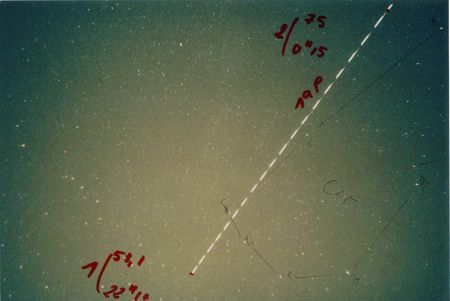Revosat_june_recap_sat_2006_2008
Revosat_june_Summary_2005_2008_REVO
Revosat has gathered all the
photographied satellites over AUFFARGIS (France).With these photos,
their trajectories have been determined ie height, inclination orbit,
ascending node.
We have reported the results on a diagram x axis=inclination of orbit and y axis= frequency.
ORBIT 49/53 °.Many observations have been carried out about
docking ISS/SHUTTLE.Shuttle with Columbus (ESA) and docking of ATV
jules Verne/ISS. Abrixas and Rosat two satellites operating in X rays
have been well observed. They were at the end of their life so they
were more luminous every month.
ORBIT 57°.Parameters of Uars , Lacrosse 3 and 5 have been well determined. Be careful of Uars changing rapidly of perigee.(Solar or NASA effect).The decaying of USA 193 has been observed till the rocket hit.
ORBIT 68°.Lacrosse 2 and 4 (Lacrosse 4 roc too) had been observed.
ORBIT 71°.
These satellites are Spy Russian one. They are very high in the sky ie
850 kms and are the last to be seen before the full night.
ORBIT 82°.These satellites are spy Russian too. They are typically 500 kms high and some are interesting because they are decaying very rapidly from 400 kms. (See Revosat oct 2005 Cosmos 807 roc and Meteor 1-7).
ORBIT 86.
All observations are IRIDIUM flares. These observations are very
interesting because they allowed to compare time and location of the
flares from the photos Revosat with Heavens above data.
ORBIT 98°.These
satellites are environmental one.(heliosynchronous) They are numerous
and mainly observed on summer because they photograph Earth with the
light of the Sun so their transit take place two or three hours before
midnight so 21/22 h TU over France consequently 9/10 h on the other
side of earth Antipode to get photos with good contrast. Twilight took place at 21/22 hours only on summer and its duration is maximum on this season.
Envisat,
Metop and Terra are perfectly heliosynchronous. But Okean O roc, Resurs
1-4 roc, Helios 1A roc are quasi heliosynchronous ie their transit are
sooner every month concerning Okean O roc and Resurs 1-4 roc and later
concerning Helios 1A roc. Evening satellite, Okean O roc will be seen
on morning from 2009.
Cosmos
1484 and Cosmos 1484 roc are well visible and their respective
precession are interesting because at the beginning (launching 1983)
they were transiting together. Their transits are later every month.
ORBIT 108°.This
orbit is SEASAT one and is particular because the shift is retro. It is
the first oceano satellite before Topex Poseidon and so on. No
explication about the choice of 108 degrees inclination. Its orbit
shifts slowly retro with respect of sun. All is linked with Moon
movement ie tides.





